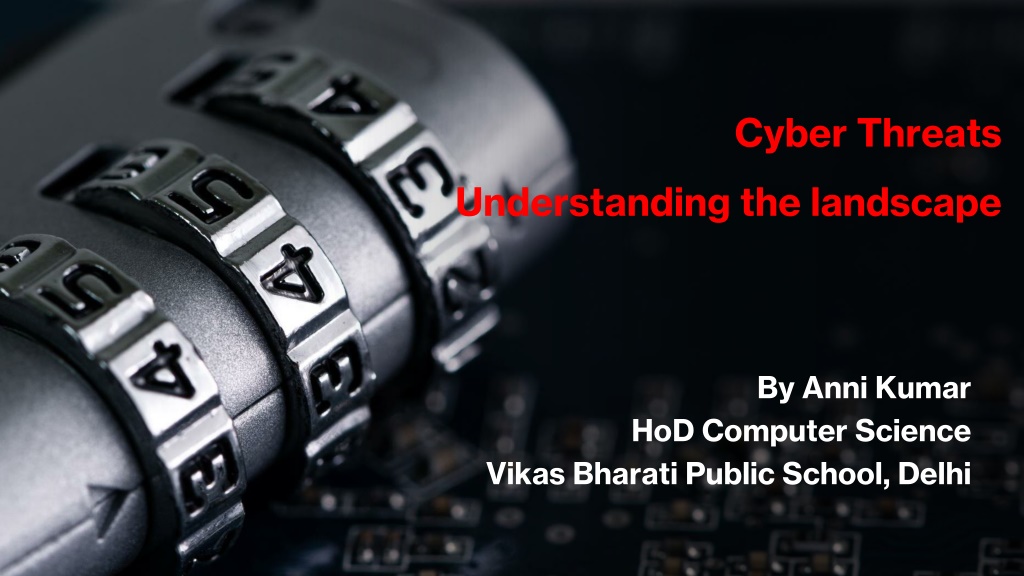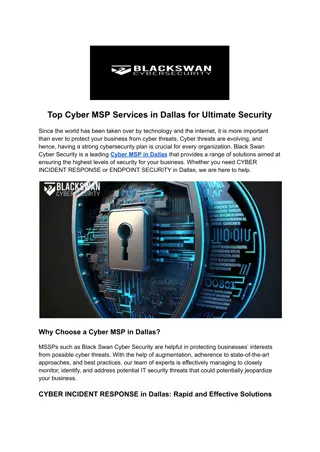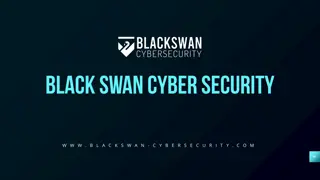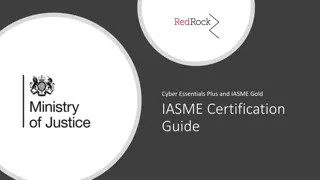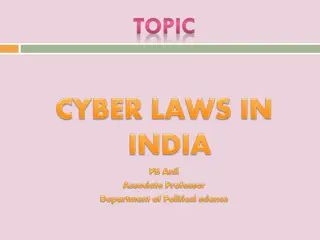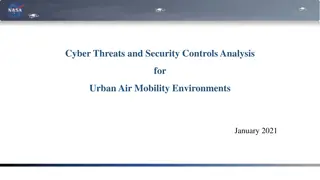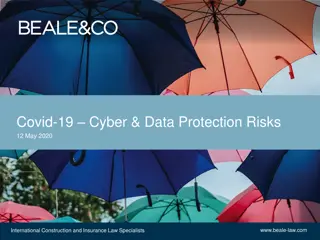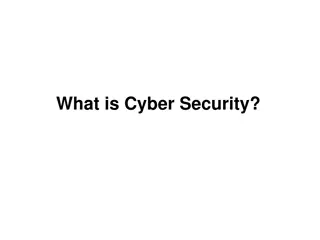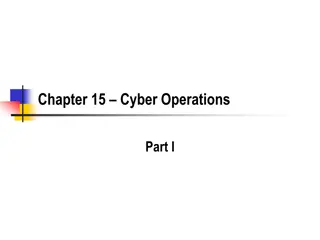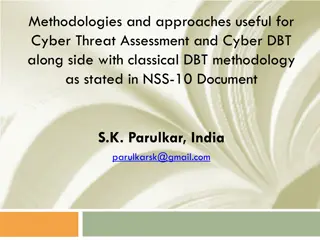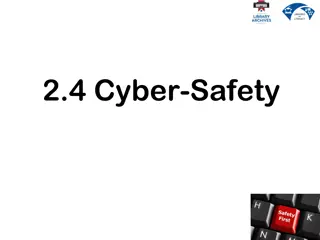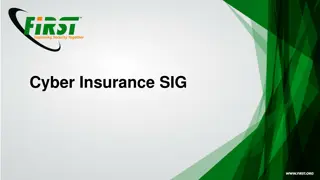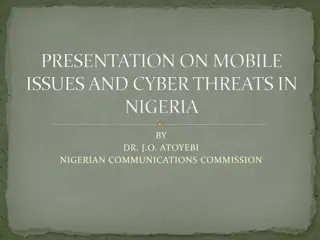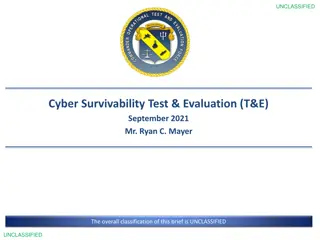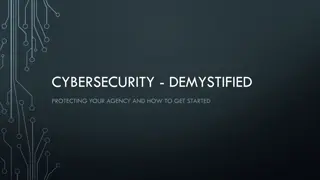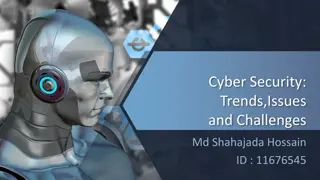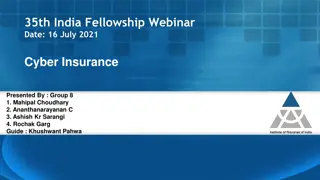Understanding Cyber Threats in Today's Digital Landscape
Cyberspace is a vast realm encompassing the Internet, where we engage in various activities ranging from communication to entertainment. With the majority of children exposed to the online world, cybersecurity awareness is crucial to tackle the rising cyber threats. These threats include job frauds, hacking, identity theft, banking frauds, cyberbullying, email spoofing, and more. It's essential to educate individuals on different types of cyber threats to safeguard personal information and prevent malicious activities.
Download Presentation

Please find below an Image/Link to download the presentation.
The content on the website is provided AS IS for your information and personal use only. It may not be sold, licensed, or shared on other websites without obtaining consent from the author. Download presentation by click this link. If you encounter any issues during the download, it is possible that the publisher has removed the file from their server.
E N D
Presentation Transcript
Cyber Threats Understanding the landscape By Anni Kumar HoD Computer Science Vikas Bharati Public School, Delhi
What is Cyberspace? Cyberspace encompasses everything related to the Internet. It s where we communicate with friends and family, play video games, download music, and watch TV shows and movies once our homework is done. Adults also use it for essential tasks like banking and shopping.
Why cybersecurity awareness is crucial?
As many as 93% of children from ages 8 to 17 are on the internet, nearly three out of four experience at least one cyber threat.
What are Cyber Threats? A cyber threat refers to an attack on important information stored on a computer or a network. In such attacks, an individual or a group gains unauthorized access to personal details with the intention to damage or steal sensitive data, such as intellectual property, IT assets etc.
Different Types of Cyber Threats Job Frauds They are the different possible ways that can be used to attack using internet or mobile technology. Hacker is anyone who uses / exploits technology operations or causing financial/ reputational loss to people. Identity Theft Banking Frauds Cyber Threats Cyber Bullying Email Spoofing Malicious File applications Social Engineering
Email Spoofing Sending out e-mails that look like genuine and from a trusted e-mail ID but they are not.
Cyber Bullying Using internet or mobile technology to intentional harass or bully someone by sending rude, mean or hurtful messages, comments and images/videos. A cyber bully can use text messages, emails, social media platforms, web pages, chat rooms etc. to bully others.
Identity Theft Identity theft is the crime of using the personal or financial information of another person to commit fraud, such as making unauthorized transactions or purchases. Identity theft is committed in many ways and its victims are typically left with damage to their credit, finances, and reputation.
In 2018, a private employee, Naveen Jyothi, filed a police complaint alleging that fraudsters used his personal information to obtain a credit card from the State Bank of India in his name. Fraudsters used the credit card to spend Rs 88,654. Police conducted the investigation, and the fraudsters involved were apprehended. Kim Kardashian was also a victim of ID theft in 2014. Luis Flores, Jr., 19, called American Express to be Kim Kardashian and modified her social security number and address to his own so he could receive new cards.
Lets understand Financial Fraud take place through Phishing Links
Financial Fraud using online Market places
Financial Fraud Fraud cases in Indian banks surged to 36,075 in FY24 from 9,046 in FY22, a nearly 300% increase, while the amount involved dropped by 46.7% to Rs 13,930 crore. Most frauds occurred in digital payments, but the highest value frauds were in loan portfolios, with public banks contributing the most by value.
Emerging information security threats and challenges Use of artificial intelligence (AI) by attackers AI is a double-edged sword; it is improving security solutions but at the same time is leveraged by attackers to bypass those solutions. Part of the reason for this is the growing accessibility to AI. In the past, developing machine learning models was only possible if you had access to significant budgets and resources. Now, however, models can be developed on personal laptops. This accessibility makes AI a tool that has expanded from major digital arms races to everyday attacks. While security teams are using AI to try to detect suspicious behaviour, criminals are using it to make bots that pass for human users and to dynamically change the characteristics and behaviours of malware.
General Tips keep yourself safe Always keep your systems/devices (desktop, laptop, mobile) updated with latest patches. Always use virtual keyboard to access net-banking facility from public computers; and logout from banking portal/website after completion of online transaction. Also ensure to delete browsing history from web browser (Internet Explorer, Chrome, Firefox etc.) after completion of online banking activity. Protect systems/devices through security software such as anti-virus with the latest version. Do scan all e-mail attachments for viruses before opening them. Avoid downloading e-mail attachments received in e-mails from unknown or un-trusted sources. Always download software or applications from known trusted sources only. Never use pirated software on your systems/devices. Ensure all devices/accounts are protected by a strong PIN or passcode. Never share your PIN or password with anyone. Be careful while sharing identity proof documents especially if you cannot verify the authenticity of the company/person with whom you are sharing information. Do not share your net-banking password, One Time Password (OTP), ATM or phone banking PIN, CVV number etc. with any person even if he/she claims to be an employee or a representative of the bank and report such instances to your bank. Note the IMEI code of your cell phone and keep it in a safe place. The operator can blacklist/block/trace a phone using the IMEI code, in case the cell phone is stolen. Observe your surroundings for skimmers or people observing your PIN before using an ATM. Always change the default admin password on your Wi-Fi router to a strong password known only to you. In addition, always configure your wireless network to use the latest encryption (contact your network service provider, in case of any doubt). Discuss safe internet practices and netiquettes with your friends and family regularly! Motivate them to learn more about cybercrimes and safe cyber practices. Do not save your card or bank account details in your e-wallet as it increases the risk of theft or fraudulent transactions in case of a security breach. Be cautions while browsing through a public Wi-Fi and avoid logging in to personal & professional accounts such as e-mail or banking on these networks. If you think you are compromised, inform authorities immediately.
Where to Report a Cyber Fraud? Visit the nearest police station immediately. To report cybercrime complaints online, visit the National Cyber Crime Reporting Portal. This portal can be accessed at https://cybercrime.gov.in/. In this portal, there are two sections. One section is to report crimes related to Women and Children (where reports can be filed anonymously as well). Another section is to report other types of cybercrimes. You can also file a complaint offline by dialing the helpline number .
